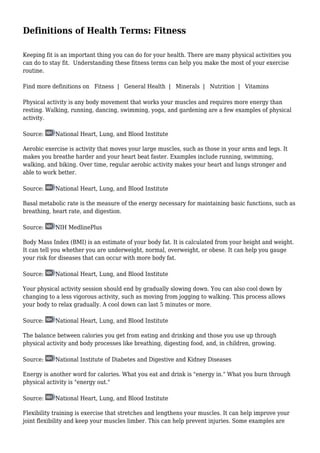
Definitions of Health Terms: Fitness
- 1. Definitions of Health Terms: Fitness Keeping fit is an important thing you can do for your health. There are many physical activities you can do to stay fit. Understanding these fitness terms can help you make the most of your exercise routine. Find more definitions on Fitness | General Health | Minerals | Nutrition | Vitamins Physical activity is any body movement that works your muscles and requires more energy than resting. Walking, running, dancing, swimming, yoga, and gardening are a few examples of physical activity. Source: National Heart, Lung, and Blood Institute Aerobic exercise is activity that moves your large muscles, such as those in your arms and legs. It makes you breathe harder and your heart beat faster. Examples include running, swimming, walking, and biking. Over time, regular aerobic activity makes your heart and lungs stronger and able to work better. Source: National Heart, Lung, and Blood Institute Basal metabolic rate is the measure of the energy necessary for maintaining basic functions, such as breathing, heart rate, and digestion. Source: NIH MedlinePlus Body Mass Index (BMI) is an estimate of your body fat. It is calculated from your height and weight. It can tell you whether you are underweight, normal, overweight, or obese. It can help you gauge your risk for diseases that can occur with more body fat. Source: National Heart, Lung, and Blood Institute Your physical activity session should end by gradually slowing down. You can also cool down by changing to a less vigorous activity, such as moving from jogging to walking. This process allows your body to relax gradually. A cool down can last 5 minutes or more. Source: National Heart, Lung, and Blood Institute The balance between calories you get from eating and drinking and those you use up through physical activity and body processes like breathing, digesting food, and, in children, growing. Source: National Institute of Diabetes and Digestive and Kidney Diseases Energy is another word for calories. What you eat and drink is "energy in." What you burn through physical activity is "energy out." Source: National Heart, Lung, and Blood Institute Flexibility training is exercise that stretches and lengthens your muscles. It can help improve your joint flexibility and keep your muscles limber. This can help prevent injuries. Some examples are
- 2. yoga, tai chi, and pilates. Source: National Heart, Lung, and Blood Institute Heart rate, or pulse, is how many times your heart beats in a period of time -- usually a minute. The usual pulse for an adult is 60 to 100 beats per minute after resting for at least 10 minutes. Source: National Heart, Lung, and Blood Institute The maximum heart rate is the fastest your heart can beat. Source: National Heart, Lung, and Blood Institute Perspiration, or sweat, is a clear, salty liquid produced by glands in your skin. It is how your body cools itself. Sweating a lot is normal when it is hot or when you exercise, feel anxious, or have a fever. It can also happen during menopause. Source: NIH MedlinePlus Resistance training, or strength training, is exercise that firms and tones your muscles. It can improve your bone strength, balance, and coordination. Some examples are pushups, lunges, and bicep curls using dumbbells. Source: National Heart, Lung, and Blood Institute Your target heart rate is a percentage of your maximum heart rate, which is the fastest your heart can beat. It is based on your age. The activity level that is best for your health uses 50-75 percent of your maximum heart rate. This range is your target heart rate zone. Source: National Heart, Lung, and Blood Institute Your physical activity session should start at a slow-to-medium pace to give your body a chance to get ready for more vigorous movement. A warm up should last about 5 to 10 minutes.
- 3. Source: National Heart, Lung, and Blood Institute Your weight is the mass or quantity of your heaviness. It is expressed by units of pounds or kilograms. Source: NIH MedlinePlus http://www.nlm.nih.gov/medlineplus/definitions/fitnessdefinitions.html